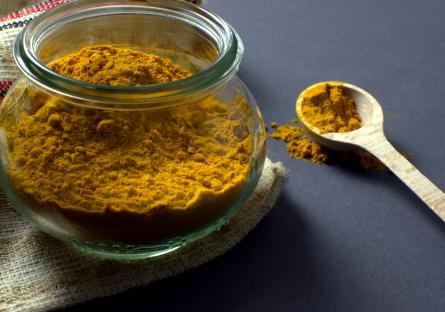This article appears for archival purposes. Any events, programs and/or initiatives mentioned may no longer be applicable.

In some cultures the color yellow symbolizes optimism, energy, and happiness. Yellow is the color of sunshine; it’s bursting with vitality. A lot of healthy things to eat are yellow—like turmeric. It may not be a household name in North America but it’s a popular ingredient in kitchens across the world. Turmeric isn’t just a flavorful addition to your cooking—it’s also very healthy and contains qualities that can improve your quality of life over time.
Read on as we take a close look at turmeric.
What Is Turmeric?
Turmeric is a spice. A staple ingredient in Indian cuisine, it comes from a plant in the ginger family that is native to Southeast Asia. The underground stem of the plant is what's used to make turmeric. In addition to being a spice it's often used as a form of medicine and can also be turned into a paste that's used to treat skin conditions.
Is It Good For You?
Turmeric contains an antioxidant called curcumin which possesses anti-inflammatory properties. Studies have found that curcumin can help reduce swelling and prevent blood clots by stopping platelets from clumping together. Curcumin also helps improve the functioning of the endothelium, which is the lining of your blood vessels. That improved functionality can reduce the risk of heart disease and also improve the regulation of blood pressure. Ongoing research efforts have also found that turmeric may possess some cancer-fighting properties as well—as an antioxidant, it attacks free radicals in the body that can accelerate the breakdown of organs, aging, and other maladies.
In addition to being an anti-inflammatory, studies have found that curcumin has antidepressant effects as well.
What Foods Contain Turmeric?
Turmeric isn’t naturally occurring in fruits and vegetables like other nutrients and healthy additives, but can be readily found in certain kinds of cuisine. If you enjoy curries, you’re in luck: turmeric is the cornerstone of curries! Turmeric gives curry powder its bright yellow color. In addition to curries, turmeric can be found in most Indian dishes. Indonesian, Moroccan, and Thai cuisine are also heavy on turmeric.
If you like to experiment with cooking at home, consider adding turmeric when you’re cooking vegetables, meats, and fishes. Turmeric pairs very well with vegetables and also tastes great in legumes like lentils. Turmeric can also be used as a more affordable substitute for recipes that use saffron for its yellow color.
Can You Take Too Much Of It?
One thing to keep in mind is that turmeric is poorly absorbed into the bloodstream. Our bodies break down and filter out curcumin quickly, so it can be difficult to consume an adequate amount. The trick is to eat turmeric-rich foods that also contain black pepper, as black pepper contains piperine which helps with absorption. If you're taking turmeric supplements check to see if the supplements also contain piperine or phytosome technology
While it’s very difficult to take too much turmeric, it can happen. The side effects of excess turmeric aren’t too serious, but if you notice any of the following you should ease off it for a bit and see a doctor:
- Digestive issues
- Bloating
- Diarrhea
- Headache
- Nausea
- Skin rash
- Excessive flatulence
Article by Austin Brietta
Want more wellness tips? Check out these stories: